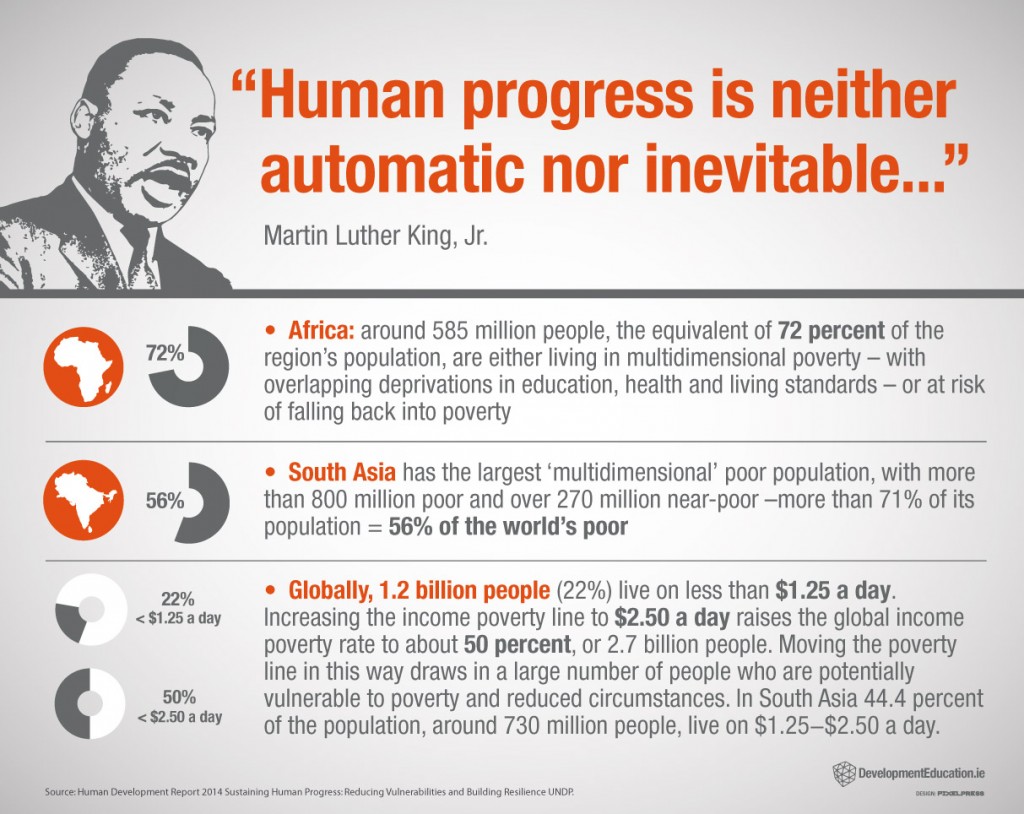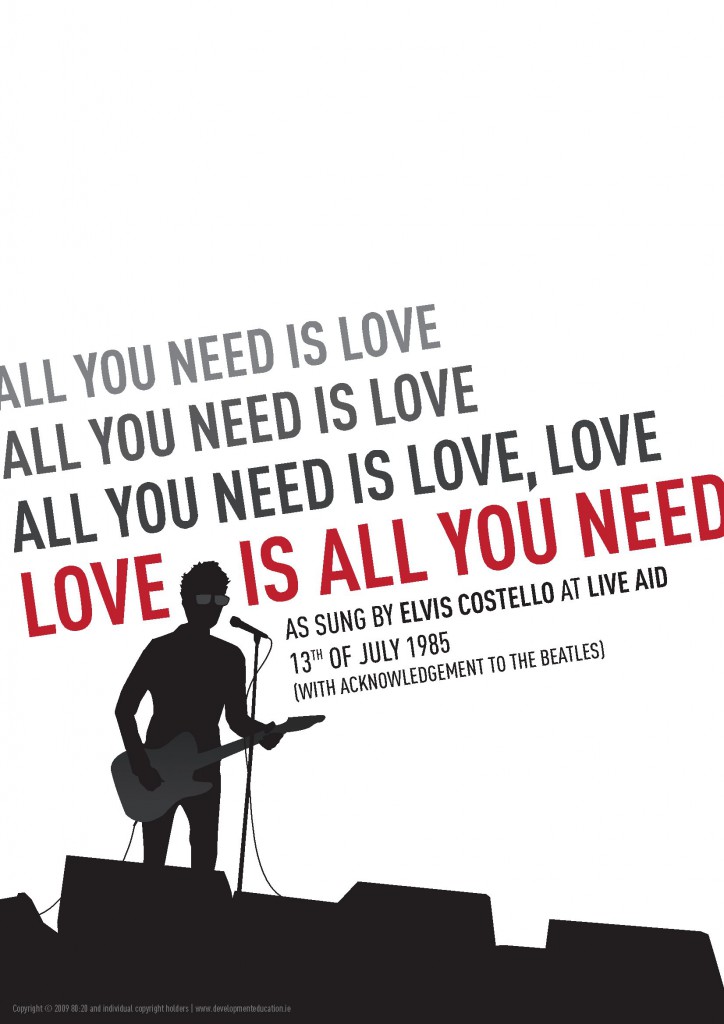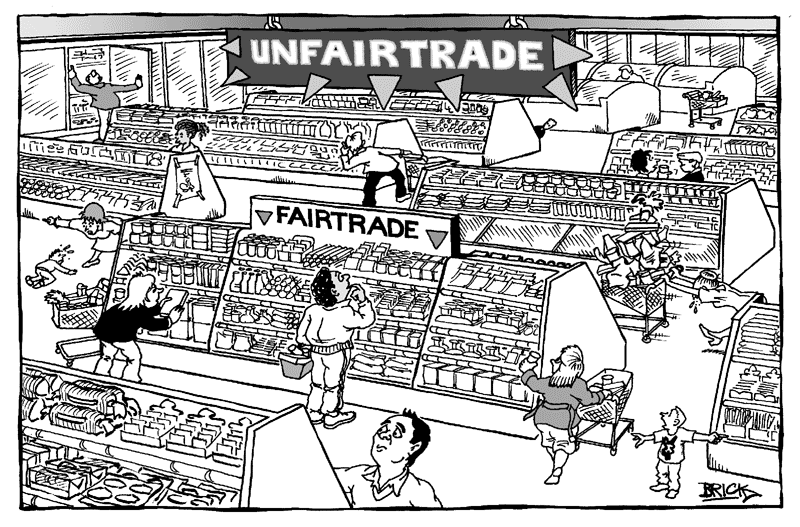There are quite literally hundreds of starter activities to introduce international development ideas, debates and realities. Here, we’ve chosen 30 starting points and grouped them by different types of learning formats:
- Using statistics
- Using a cartoon
- Using a photo
- Using a piece of text
- Using a poster or stimulus sheet
- Using an infographic
- Using a research report
- Using quotes
- Using a film / video
Using statistics: 80:20 (or, in 2014, 83:17)
This most basic statistic is our ‘shorthand’ way of introducing one of the most significant ‘facts’ about our world – today over 80% of totalorld population lives in the less developed or poor world while less than 20% live in the developed or rich world. This statistic has profound implications for us all as well as for the planet today and in the future. The statistic can be used to initiate a discussion and to encourage responses to a series of fundamental questions:
- What is our immediate reaction to the figures – surprise, concern, challenge, opportunity, worry etc.?
- What are the implications of this statistic, for the rich, the poor, the planet, you?
- Do you think society here in the West actually understands that the world is shaped in this way?
- Do you think life opportunities and human development are distributed in the same way or might they be different? Why?
- Does the figure capture all the realities of wealth and poverty in the world?
- What are some of the problems associated with describing the world in this way? etc.
The statistic (which is really only a snapshot) and the discussion it often stimulates can form the basis for far more extended enquiry and debate.
The current population figures are actually as follows (2015):
| Area | Population (in millions) | % of total |
| World | 7,349 | 100% |
| Developed Regions | 1,135 | 15.5% |
| Less Developed Regions | 6,214 | 84.5% |
| (Least Developed Regions) | (954) | (13%) |
Source: UNFPA (this report can be downloaded free and contains all the basic statistics you might need to take the discussion further).
Many people have developed this idea further and often present the world as if it were a village of 100 people | infographic | Also see this as a group activity included in the 80:20 book.
The same idea is usefully explored in an infographic and video at The Miniature Earth project and a set of excellent and accessible posters on the issue by Toby Ng (readily available as images).
Using a cartoon
At developmenteducation.ie, we find cartoons particularly useful in introducing development education and its ideas – they immediately provoke a response, they stimulate debate and they suggest so many other questions. Our cartoon gallery offers many such cartoons.
For example, use the Unfairtrade cartoon by Brick.
- What are the core messages or ideas in the cartoon?
- Do you think it reflects our world accurately?
- What does it say about consumption and well-being in the world?
- How do you respond to its messages?
- Has the situation changed in recent years – for better or for worse? etc.
For more activities relating to the use of cartoons, see the Using Cartoons section. Any number of these can help when introducing development education
Using a photo
Photos have become a vital way of ‘seeing’ and ‘feeling’ the world; they evoke emotions, reactions and questions. Using a photo (or a set of photos) to initiate a discussion on development education is one of the easiest and often most productive way to get the conversation going. And, photos are a very flexible tool for learning as everyone can read them at their own pace and in their own context.
Our photo gallery offers a range of photos with which you could work along with a detailed set of ideas on how to use them creatively. There are many straight forward and accessible activities included here for introducing and exploring development education issues.
For example:

- Describe the photo and what it might be about?
- What words would you use to describe the photo?
- Is it a positive image or a negative one in your view?
- What might the people in the photo be thinking? Doing? etc.
The use of photos has always been controversial and our choice of photos can heavily influence and shape how people see and understand the world.
So many of the photos we routinely see concerning issues in the developing world are presented with an agenda in mind – be it fundraising, politics, advertising, campaigning etc. For this reason, Irish NGOs have agreed a ‘code of conduct’ to assist agencies in thinking about their choices of images and the information that they should include in order to provide context and content. The Dóchas Code can be accessed (and used for discussion and debate) here.
Using a piece of text
A carefully chosen piece of text from a report, website, newspaper or book is often a very effective way to introduce development education. The pieces below (extracted from the Huffington Post and from Eduardo Galeano) offers much food for thought about one, the world’s priorities and two, ‘Western’ values; they could be distributed to each member of the group with the following questions to stimulate debate:
- Is it fair or reasonable to make these comparisons or comments?
- What message is the speaker/author trying to send and to whom?
- Is it fair to ‘blame’ consumers or those who play golf?
- Are these views representative of a majority of people?
- What responsibilities do we have as regards these views/issues?
- Who has a role and responsibility for covering the costs?
- Why do we have these priorities and not the others mentioned?
- Why do some people hold such views?
These pieces have been deliberately chosen to stimulate discussion and debate on fundamental issues and challenges.
Edited extract from: If Anybody Ever Tells You It’s Too Expensive To Solve the World’s Problems, Show Them This by Amanda Scherker, the Huffington Post, January 29th, 2014:
The world’s problems are so staggering that they sometimes feel completely unchangeable. Every day seems to leave more suffering, disease and tragedy in its wake. There’s no question that our problems are vast, but what would it really cost to solve some of greatest human tragedies we face?
Here are some stats that put the world’s problems in perspective:
For $26 billion more a year, we could provide a basic education to every child in the world by 2015 – that’s according a 2013 study by UNESCO; the report estimated that 200 million children around the globe have not completed primary school, and 250 million children who are in school cannot read or count well. An estimated $54 billion in total is necessary to provide a basic education in all low-income and lower-middle-income countries. At the time of the report, a sum of $28 billion was being provided, of which $3 billion came from foreign aid.
That might seem like a lot, but let’s consider that…the U.S. spends an annual $25 billion on golf – and that’s just consumer spending. Americans allocate $4 billion to equipment, $1 billion to apparel sales and $20 billion to green fees, according to estimates from the National Golf Foundation. If we then consider professional golf, trade shows and golf travel, that number’s actually a staggering $65 billion annually.
For $190 billion a year, we could cut the number of people without access to clean water and basic sanitation facilities in half – in 2012, the World health organisation predicted that its Millennium Development Goal of providing access to clean water and basic sanitation for half of those who currently lack it would require a $190 billion annual investment for five years. That includes creating new resources and maintaining existing infrastructure. At the time of the report, 783 million people had subpar drinking water, and 2.5 billion people lacked access to proper sanitation facilities.
That’s a massive sum of money, but meanwhile … the U.S. loses $190 billion in annual federal and state revenue due to offshore tax dodges – that’s according to a study by the US PIRG Education Fund which investigated the hidden costs of tax loopholes and offshore havens.
For $115, Doctors Without Borders can give infection-fighting antibiotics to 40 children – the cost of providing the antibiotics is $100, according to Doctors Without Borders.
That’s $100 you could spend on other essentials, but let’s also consider that… the average U.S. household wastes $100 every year paying for electronic devices that are turned off, yet still plugged in – that’s according to the Environmental Protection Agency’s Energy Star Program which details the hidden cost of so-called “energy vampires” — devices that consume power when they are turned off, but still plugged into an outlet.
For $44 billion a year, we could end world hunger completely – at the 2009 World Summit on Food Security, Jacques Diouf, director-general of the U.N.’s Food and Agriculture Organisation said that estimate would need to be divided among infrastructure, technology and modern inputs. At the time of Diouf’s statement, there were one billion hungry people around the world. Since then, the number of people suffering from chronic hunger has declined to an estimated 842 million for 2011-2013.
That’s a ton of money, but look at this way…the U.S. spent $46.5 billion on shopping online during the 2013 holiday season alone – that’s the amount of e-commerce spending Americans did between Nov. 1 and Dec. 31 in 2013, according to comScore, Inc. a global leader in digital business analytics.
For an additional $13.1 billion, every mother and new-born in the developing world could get maternal and prenatal care – a report in May 2013 from the Guttmacher Institute, a non-profit that works to advance reproductive health, found that a total spending budget of $24 billion would be required to provide care for all mothers and new-borns. Of that figure, $8.5 billion would go to direct care costs and $15.5 billion for program and system costs..
Coming up with this increase in funding wouldn’t be easy, but just consider that in the U.S. alone…We spent $13 billion on iPhone and iPad apps and in-app purchases in 2013.
Source: Huffington Post, 2014
Edited extract from Eduardo Galeano 2013 Children of the Days, London, Penguin, page 27:
‘I do not admit that a great wrong has been done to the Red Indians of America or the black people of Australia…by the fact that a stronger, a higher-grade race…has come in and taken their place.’
Winston Churchill speaking before the Palestine Royal Commission in 1937
Other useful and stimulating pieces can be extracted from the annual Human Development Report published by the UN Human Development Programme and from this website focused on environment and sustainable development issues as outlined by Indian environmental activist Vandana Shiva.
Using a poster or stimulus sheet
Posters related to human development and/or human rights are readily available online or from a variety of organisations. As ‘stand-alone’ resources they are especially suited to generating discussion and debate. The Guardian newspaper has put together a collection of some of Amnesty International’s posters over a 50 years period – they could offer a wonderful place to start a discussion on the human rights dimension of development education.
developmenteducation.ie has also offered a selection of ‘stimulus sheets’ from the 80:20 Educating and Acting for a Better World resource 5:50:500.
You could use the Environmental Tipping Points sheet to generate an introductory discussion on many key issues associated with this dimension of development education.
80:20 has also produced a set of challenging posters on the theme of aid entitled Think Again with supporting ideas on using them.
Using an infographic

Using an infographic (or a set of them) is a very useful and productive way of introducing DE ideas and debates as they summarise key issues and data in ‘bite size’ chunks. The graphics on this website (and some sample trigger sheets from 5:50:500) will help to start you off and additional excellent graphics can be found from USA-based GOOD magazine’s infographics section.
- Give small groups (or individual participants in an event) different graphics, ask them to examine and discuss them and then present the information obtained and the debate engaged to the full group
- Provide individuals or groups with a key statistic and invite them to make their own infographic
- Find additional graphics online that present ideas and/or data from a justice, human rights, sustainable development perspective etc. This is much easier than it sounds! Take a look on social media for examples, such as on Facebook, Instagram and on Twitter with material tagged as #infographic

Using a research report
Many NGOs and research institutes produce research reports analysing and commenting on current trends and challenges associated with development, environment, human rights and other issues. Such reports (or extracts from them) offer rich pickings for those wanting to introduce development education. Below, we include an extract from a January 2014 briefing paper by Oxfam entitled Working for the Few with some questions for discussion.
Extract:
- Almost half of the world’s wealth is now owned by just 1% of the population; the wealth of the 1% richest people in the world amounts to $110 trillion – that’s 65 times the total wealth of the bottom half of the world’s population
- The bottom half of the world’s population owns the same as the richest 85 people in the world
- 7 out of 10 people live in countries where economic inequality has increased in
the last 30 years
- The richest 1% increased their share of income in 24 out of 26 countries for
which we have data between 1980 and 2012
- In the US, the wealthiest 1% captured 95% of post-financial crisis growth since 2009, while the bottom 90% became poorer.
Source: Oxfam
One other set of stats to consider are the Sustainable Development Goals, which are estimated to cost the world between $3.5 trillion and $5 trillion a year between 2016 and the end of 2030 (source: report in the New York Times on 21 Sept 2015).
Questions to consider (in group work or individually):
- What is your reaction to these figures and why?
- Do you think levels of wealth in the world are somehow linked to levels of poverty?
- Why is inequality important as an issue?
- What are the implications of figures such as these?
- What can governments do? What can corporations do?
- Where do we fit in?
Extracts could also be used from other interesting reports such as:
- The Living Planet Report 2014 – an annual report exploring sustainability issues
- Gender Equality and Sustainable Development: A world survey on the role of women in development 2014 – a 2014 report on women and sustainable development
Using quotes
Another effective way of introducing development education is through the use of a challenging or controversial quote that can stimulate different reactions and thoughts. This is especially so if you choose a quote from a developing world writer or commentator – their views are so very often at odds with those of ‘western commentators’. This contrast can stimulate effective discussion and, usually debate.
Below, we include 3 quotes from 3 well-known writers/commentators from the developing world – these can be readily used to stimulate debate.
“The last four or five hundred years of European contact with Africa produced a body of literature that presented Africa in a very bad light and Africans in very lurid terms. The reason for this had to do with the need to justify the slave trade and slavery. … This continued until the Africans themselves, in the middle of the twentieth century, took into their own hands the telling of their story.”
– Nigerian author Chinua Achebe, 2000
………………………………..
“In 1492, the natives discovered they were Indians, discovered they lived in America, discovered they were naked, discovered that the Sin existed, discovered they owed allegiance to a King and Kingdom from another world and a God from another sky, and that this God had invented the guilty and the dress, and had sent to be burnt alive who worships the Sun the Moon the Earth and the Rain that wets it.”
– Uruguayan author, Eduardo Galeano, 2012
………………………………..
“Paradigm wars over water are taking place in every society, East and West, North and South. In this sense, water wars are global wars, with diverse cultures and ecosystems, sharing the universal ethic of water as an ecological necessity, pitted against a corporate culture of privatisation, greed, and enclosures of the water commons. On the one side of these ecological contests and paradigm wars are millions of species and billions of people seeking enough water for sustenance. On the other side are a handful of global corporations…assisted by global institutions like the World Bank, the World Trade Organisation (WTO), the International Monetary Fund (IMF), and G-7 governments.”
– Indian scientist and environmental activist Vandana Shiva in Water Wars: Privatisation, Polution and Profit 2002)
- Which quote strikes you most and why?
- What is your response to the world views presented by these 3 writers?
- In what ways are their views different from ‘western views’?
- In what ways do you agree or disagree with these authors?
Using a video/film
There are now so many videos/short films/documentaries ‘out there’ that your biggest problem is likely to be choosing which one to use to introduce development education. Developmenteducation.ie offers a video library, which will give you plenty of starting points and ideas.
Here are some videos to start the discussion:
– introduces the idea of the world as 100 people (source: the Diversity Speaker)
– a statistical overview from National Geographic; plenty to argue about
– a TED talk from one of the best, Hans Rosling; his work is well worth considering
– a clever video on ‘The Girl Effect’ from the Girl Effect; clever presentation on one of the most important issues
– offers a ‘take’ on future sustainable development challenges
– discusses the impact of extreme inequality
Contents:
- Doing Development Education: ideas and resources – a starter guide
- 1. Defining (and debating) development education
- 2. Thinking about development education methodologies and evaluating learning
- Method 1 – The 3-Step approach
- Method 2 – The ‘Essential Learning for Everyone’ Framework
- Method 3: asking key questions with the Development Compass Rose
- Method 4: Public education and development issues
- 3. Ten activities to introduce DE to younger age groups
- 4. Thirty activities to introduce and explore development education
- 5. Using photographs and photopacks
- 6. Using cartoons and animations
- 7. Using Posters
- 8. Using art
- 9. Using the contents of your shopping bag

